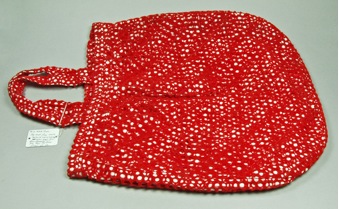Bindis
![[b]Top:[/b]Purchased for the Museum by Jenny Peck in 2001; 2001.29.1[br][b]Bottom:[/b] Collected and donated by Freya Tareporewala in 1989; 1990.15.1–.2](../../../images/stories/bindis.jpg) Top:Purchased for the Museum by Jenny Peck in 2001; 2001.29.1
Top:Purchased for the Museum by Jenny Peck in 2001; 2001.29.1
Bottom: Collected and donated by Freya Tareporewala in 1989; 1990.15.1–.2Pigment and stamps, Kathmandu, Nepal, c. 2000
Packets of stick-on bindis, Mumbai, India, 1989–2001
According to Hindu teaching, the forehead is a holy part of the body and both men and women may choose to wear a mark of their religion there.
The sacred Hindu forehead mark is known as a tilak. It represents the 'third eye' and is associated with ideas of enlightenment, insight and godly wisdom. A tilak is made with special powder known as kumkum (historically derived from turmeric or saffron), may be worn by both men and women on several parts of the body besides the forehead, and is usually applied for spiritual purposes as a blessing or to honour something or someone.
A bindi is slightly different. It may be a powdered mark but can also be a sticker or piece of jewellery, and is worn only by women on the forehead. A bindi was one of various ways a married woman indicated her status, other symbols including sindur (a red powder smeared onto the hair parting), gold bangles, mangalsutra (a special 'thread' worn as a necklace), and alta (a dye for the feet). A bride's skin might also be lightened with rice powder and rice water. Today, bindis may be worn by both married and unmarried women as a simple decorative device.
"Add a zero to a figure and its value increases ten times. Likewise place a bindi (dot) on your forehead after make-up and the charm of the face will enhance ten times."
Home Beauty Clinic, 1989
Traditionally a bindi takes the form of a red dot between the eyes – a symbol of good fortune and vitality, like the sun at dawn – applied in the morning or before entering the temple. In modern times however the bindi has evolved into a fashion statement and many variations are now available. Colourful and creative designs can be produced with this set of glitter kumkum powders and different plastic stamps from Kathmandu, which could be bought by a Nepalese local for less than £1 (GBP). The stamps are moistened with a tiny amount of moisturiser or Vaseline and then dipped in one or more pigments.
 Collected and donated by Tony Hayward in 2000; 2000.12.14–.15Also popular are stick-on re-usable shapes made of type of glass, lac, fabric or plastic. These can either be self-adhesive or applied with a little saliva. Often the stamp or sticker shapes take on the form of religious symbols such as a trident, conch shell, lotus flower, star or lamp. The multi-coloured tear-drop shaped bindis shown here are made of fabric but the sheets from which they were stamped would not have been wasted; here a perforated sheet of fabric, used to produce lots of circular red bindis, has been used to decorative effect in a two-tone bag.
Collected and donated by Tony Hayward in 2000; 2000.12.14–.15Also popular are stick-on re-usable shapes made of type of glass, lac, fabric or plastic. These can either be self-adhesive or applied with a little saliva. Often the stamp or sticker shapes take on the form of religious symbols such as a trident, conch shell, lotus flower, star or lamp. The multi-coloured tear-drop shaped bindis shown here are made of fabric but the sheets from which they were stamped would not have been wasted; here a perforated sheet of fabric, used to produce lots of circular red bindis, has been used to decorative effect in a two-tone bag.
